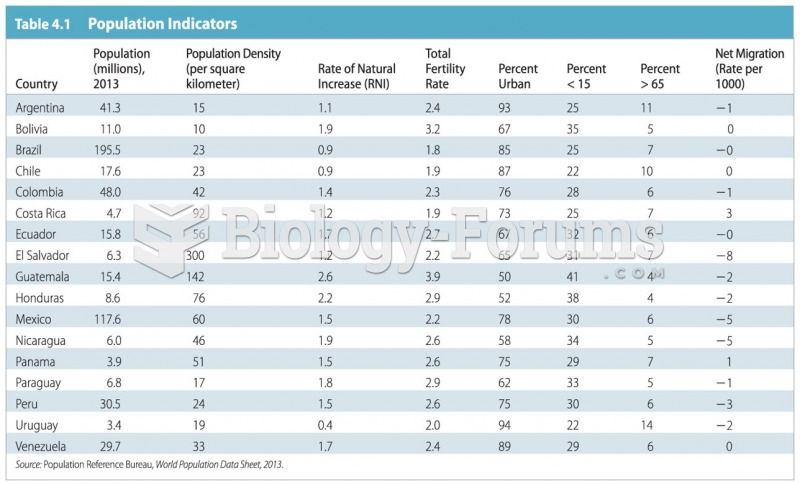Answer to Question 1
Answer: The demographic transition is a multistage model that describes how a country's population structure has changed through time. Countries move from one stage to the next as conditions change. At a given moment, we can identify the stage that each country is in. All countries have experienced some changes in natural increase, fertility, and mortality rates, but at different times and at different rates. Although rates vary among countries, a similar process of change in a society's population, known as the demographic transition, is operating. Most countries today fall between stages 2 and four.
Stage 1: For most of human history, as a result of unpredictable food supply, war and disease, the world was in stage 1. During this stage, people depended on hunting and gathering for food. A region's population increased and decreased with the availability of food. This stage had very high CBR, and CDR as well as very low NIR. No country remains in stage 1 today.
Stage 2: As a result of the industrial revolution over 200 ago, some countries generated wealth and technology, some of which was used to make communities healthier places to live. The countries that benefited from this were the developed countries. They moved into stage 2. The transition occurred much later for developing countries - about 50 years ago. In these countries, the process began with the transfer of penicillin, vaccines, insecticides, and other medicines from developed countries. These helped to control infectious diseases such as malaria and tuberculosis. The main characteristics of this stage are still high CBR, rapidly declining CDR and a very high NIR. Examples of countries still in stage 2 are Cape Verde and Senegal.
Stage 3: This would be developed countries 100 years ago. People choose to have fewer children, in part a delayed reaction to the decline in mortality in stage 2, and in part because a large family is
no longer an economic asset when families move from farms to cities. Some developing countries show evidence of moving into stage 3 in recent years, especially where government policies strongly discourage large families. The main characteristics of this stage are rapidly declining CBR, moderately declining CDR, and moderate NIR. Examples of countries in this stage are Chile and Mexico.
Stage 4: This is the stage of most developed countries in recent years. Increased access to birth control methods, as well as increased number of women working in the labor force outside the home, induce families to choose to have fewer children. As fewer women remain at home as full-time homemakers, they are less likely to be available for full-time care of young children. People who have access to a wider variety of birth-control methods are more likely to use some of them. The main characteristics of this stage are very low CBR, low, slightly increasing CDR and 0 or negative NIR. Examples of countries in this stage are Denmark and the United States.
Answer to Question 2
Answer: There are four major global population clusters. Of these, three are found in Asia. The three Asian clusters are East Asia, South Asia and Southeast Asia. The fourth cluster is Western Europe.
East Asia alone has a fifth of the world's population. This concentration includes the world's most populous country, the People's Republic of China. China's population is clustered near the Pacific Coast and in several fertile river valleys that extend inland, such as the Huang and the Yangtze, leaving much of the interior mountains and deserts sparsely inhabited. Japan and South Korea, also part of this cluster are not distributed uniformly either. Close to half of the people in these countries live in and around the three metropolitan areas of Tokyo, Osaka and Seoul.
South Asia, which includes India, Pakistan, Bangladesh and Sri Lanka has a fifth of the world's people. The largest concentration of people in this cluster lives along a 900 mile (1500-kilometer) corridor from Lahore in Pakistan, through India and Bangladesh to the Bay of Bengal. Much of this area's population is concentrated along the plains of the Indus and Ganges rivers as well as near India's two long coastlinesthe Arabian Sea to the west and the Bay of Bengal to the east.
Southeast Asia is the third important Asian cluster, with about five hundred million people, mostly on a series of islands that lie between the Indian and Pacific oceans. The islands include Java, Sumatra, Borneo, New Guinea, and the archipelago of the Philippines. With more than a 100 million inhabitants, Java, in Indonesia, has the highest concentration of people. Indonesia, consisting of 13,677 islands, is the world's fourth most populous country. The Philippines, with its string of islands also contain high population concentrations.
Western Europe, the smallest of the four major clusters in terms of population, contains one-ninth of the world's people. The region includes four dozen countries. The highest population concentrations in Europe are near the coalfields of the United Kingdom, Germany, and Belgium, historically the major source of energy for industry.






